Does your closet stress you out every morning? Honestly, that’s a pretty common problem. Lots of us just can’t seem to keep closets under control, and it makes finding your favorite shirt a daily hassle.
Remember to repin your favorite images!

A solid closet organization system can turn chaos into calm, saving you time and making mornings a bit less frantic. Whether your closet is tiny or huge, or your kids’ closets look like a disaster zone, there are solutions for every space and budget.
You’ll find everything from simple DIY wire racks like ClosetMaid ShelfTrack to fancy custom setups. The right system really helps you use every inch while keeping stuff easy to see and grab. Stick around and you’ll get a handle on all the closet system options for 2025—and maybe even figure out which one fits your life best.
Understanding Closet Organization Systems
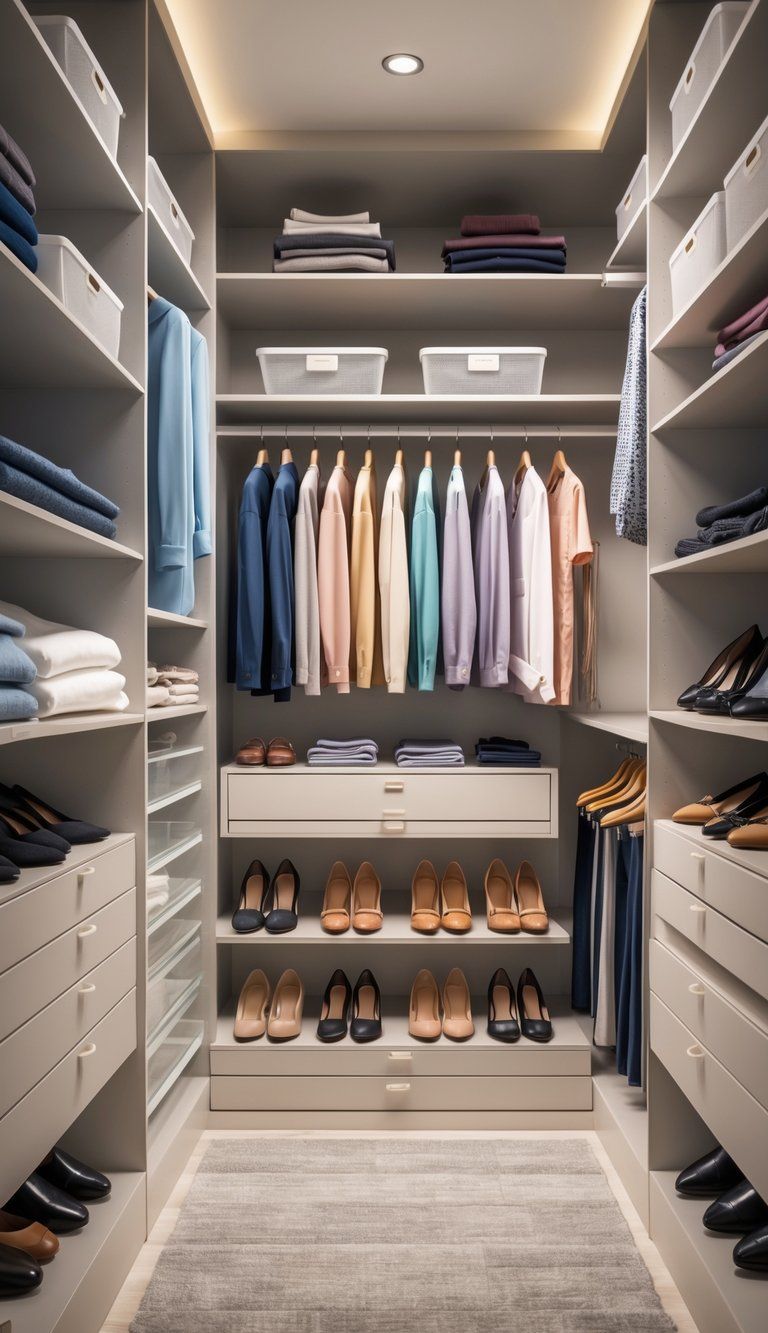
Closet organization systems take messy spaces and turn them into functional storage areas. With the right setup, you can find what you need fast and actually enjoy opening your closet.
What Are Closet Organization Systems?
Closet organization systems give your closet structure and purpose. These setups use different parts—like rods, shelves, and bins—to keep clothes and accessories in order.
Instead of just a lonely rod and a single shelf, modern closet systems offer customized storage that actually fits your stuff. Some come as kits from big box stores, while others are built just for you.
You’ll usually see these types:
- Fixed systems: You install them once and they stay put
- Modular systems: Move pieces around as your needs change
- Freestanding units: No installation, just set them up and go
You can use closet systems in any closet—bedroom, linen, coat, hall, or even those “junk” closets everyone’s got. They really can tame even the wildest storage messes.
Benefits of Organized Closets
When your closet’s organized, it’s not just about looks. You’ll save time because you can actually find things. No more digging through mountains of clothes for that one missing sock.
Organized closets also help you:
- Cut down on stress—no more morning chaos
- Save money—you’ll stop buying duplicates
- Protect your clothes and shoes—everything has its spot
- Squeeze out every inch of space—vertical storage is your friend
Give everything a home and you’ll keep things tidy without much effort. You’ll actually know what you own, so decluttering gets easier, too.
When your closet feels under control, that calm can spill over into the rest of your home. Who knew?
Key Components of Closet Systems
Good closet systems mix a few main parts to create storage that actually works. Usually, that means:
Storage units:
- Hanging rods—put them at different heights for shirts, pants, and dresses
- Shelves—fixed or adjustable
- Drawers—for folded stuff or things you want out of sight
- Cubbies—for shoes and little accessories
Organizational tools:
- Drawer and shelf dividers
- Hooks for bags and hats
- Special hangers for things like ties or scarves
- Bins and baskets for off-season or odd-shaped items
Smart systems use “zones” to group like items. Shoes get their own spot, folded clothes go together, and accessories aren’t just thrown in a pile.
The best part? You can tweak everything to fit your space and your stuff. Open shelves make grabbing things easy, but closed drawers keep things looking neat.
Types of Closets and Their Organization Needs
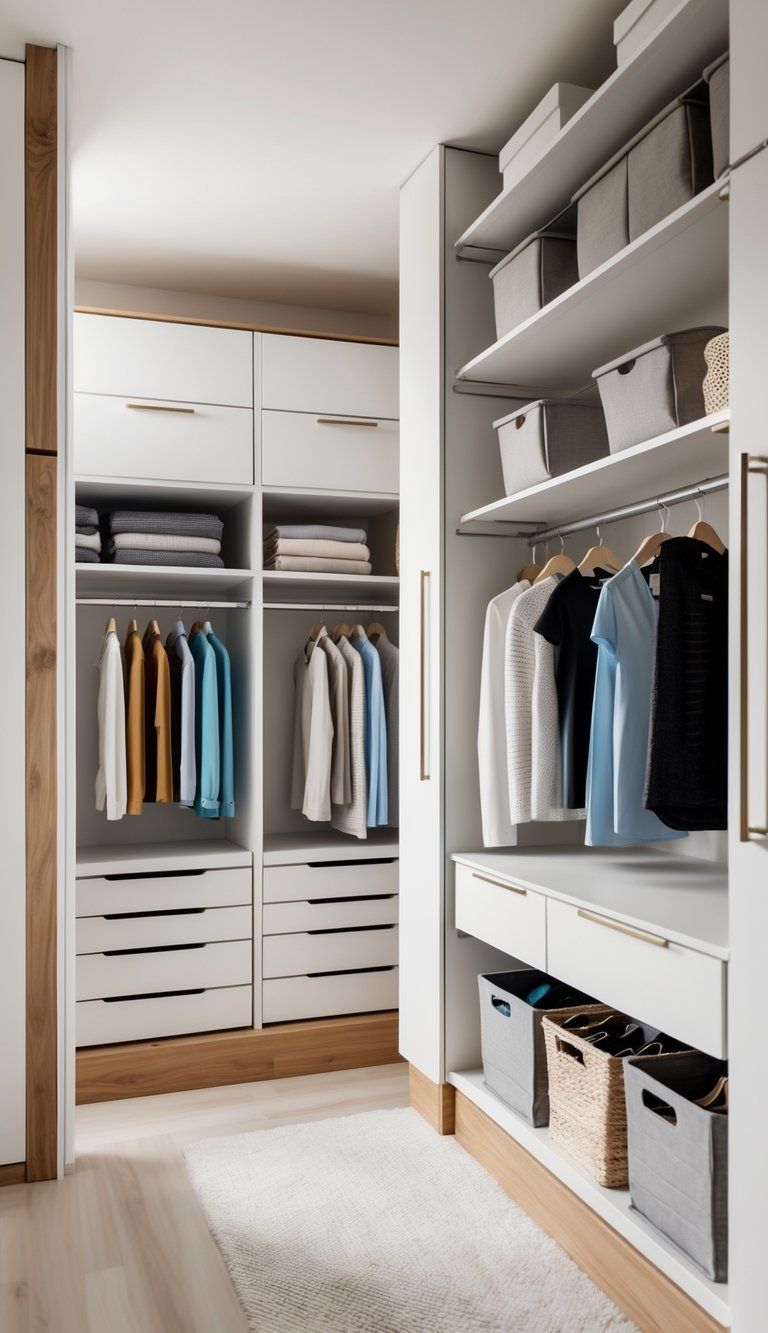
Not all closets are created equal. Each one in your home stores different things, so they need different organization tricks to work well.
Bedroom Closets
Bedroom closets hold your everyday clothes, so you want them to be both roomy and easy to use. Mixing up hanging space, shelves, and drawers usually does the trick.
Try a double-rod system—one up high for shirts, another below for pants and skirts. That simple move can almost double your hanging space.
Add shelves above the rods for stuff you don’t use much, like off-season gear. Drawers keep folded clothes and little things out of sight.
Must-haves for bedroom closets:
- Adjustable rods
- Shelves with dividers for sweaters or shoes
- Small drawers for socks and accessories
- Hooks for robes or PJs
Walk-In Closets
Walk-in closets feel like a dream, but without some planning, they can turn into a dumping ground. Their size means you can add more specialized storage.
A center island gives you more drawers and a spot to fold clothes or set things down. If you love jewelry, add a felt-lined drawer or a pull-out tray for it.
Lighting matters a lot in walk-ins. Motion-sensor lights make life easier, and LED strips help you actually see what’s on the shelves.
Upgrades for walk-in closets:
- Built-in hampers
- Big mirrors
- Shoe walls or racks
- A bench or ottoman for sitting
- Valet rods for picking tomorrow’s outfit
Reach-In Closets
Reach-in closets are everywhere, but they’re tricky because space is tight. Every inch counts, so you need to get creative.
Sliding or bifold doors save space compared to regular doors. If you’re in and out all the time, maybe just hang a curtain.
Use the back of the door for extra storage—over-the-door racks can hold shoes, scarves, or even cleaning stuff.
Space-saving ideas for reach-in closets:
- Slim hangers that keep clothes from slipping off
- Pull-out baskets for hard-to-reach spots
- Shelf dividers to keep stacks neat
- Adjustable shelves that change as your needs do
Specialty Closets: Linen, Coat, Hall, and Junk Closets
Specialty closets have their own jobs, so they need different setups.
Linen closets do best with adjustable shelves for towels and bedding. Shelf dividers keep things from toppling over, and labels help everyone put stuff back where it belongs.
Coat closets need strong hooks and hangers to handle heavy coats. Stick a shoe rack or boot tray on the floor. Toss a basket in for hats and gloves.
Hall closets usually hold a bit of everything. Try dividing space up and down—cleaning stuff on the bottom, other items up top. Clear bins with labels make finding things way easier.
Junk closets—we all have one. Use door organizers, labeled bins, and adjustable shelves to keep the mess in check. Maybe set a reminder to clean it out every few months.
Core Elements of Closet Organization Systems
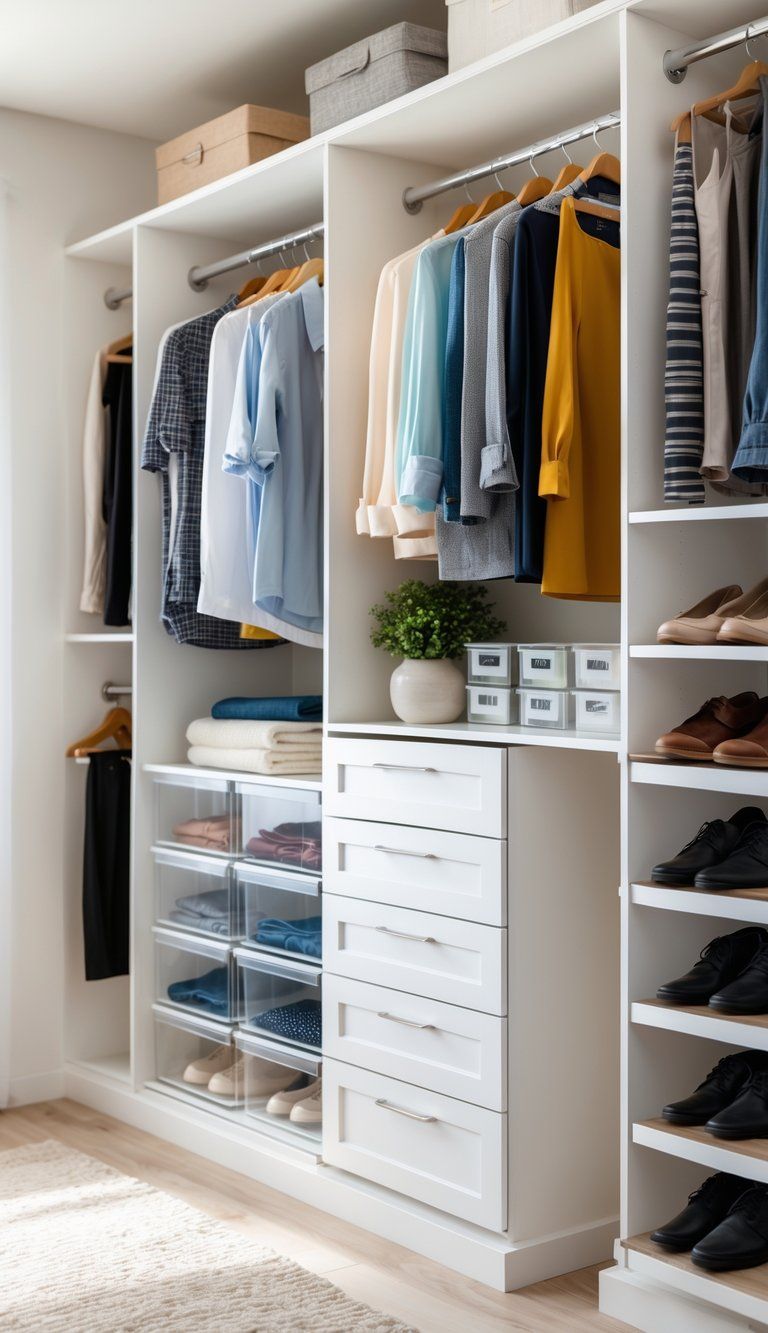
A truly organized closet needs the right mix of parts working together. These basics make up any good storage solution and can be customized for your life.
Shelves and Adjustable Shelving
Shelves are pretty much the backbone of a closet system. They hold folded clothes, accessories, and bins. Adjustable shelves make things even more flexible.
With adjustable shelving, you can change things up as your needs shift. Most systems use metal tracks or holes for shelf pins, so moving shelves up or down is simple.
Standard shelves are usually 12–16 inches deep for clothes, and 10–12 inches for shoes. Double-hang sections (two rods, one above the other) work great for shirts and shorter stuff, while single-hang areas fit longer items.
You’ll get durability and a classic vibe from wood shelves, but wire shelves offer better airflow and visibility. Try grouping like items together to keep things tidy.
Drawers and Soft-Close Drawers
Drawers give you hidden storage for stuff you don’t want out in the open—think underwear, socks, or gym clothes.
Most closet drawers are 4–10 inches high. Shallow drawers fit accessories, deep ones handle sweaters or bulkier things. Full-extension slides let you see everything, even what’s at the back.
Soft-close drawers are a nice touch—they glide shut gently without slamming. That means:
- Your stuff doesn’t get jostled
- No more pinched fingers
- Less noise
- Drawers last longer
Add clear dividers inside drawers to keep little things from getting lost. It’s a small change, but it keeps chaos at bay.
Closet Organizers and Storage Accessories
Accessories take a basic closet and make it work for real life. These extras solve specific storage hassles and help you use every bit of space.
Handy closet accessories:
- Valet rods to plan outfits
- Pull-out racks for ties and belts
- Velvet-lined trays for jewelry
- Shoe racks and cubbies
- Pull-down rods for hard-to-reach spots
Baskets and bins are lifesavers for seasonal stuff or things you rarely use. Clear bins show you what’s inside, while fabric ones look softer and more homey.
Don’t forget hooks for robes, bags, or tomorrow’s clothes. They use up wall and door space you’d otherwise ignore. Good lighting matters too—try LED strips or motion lights to make finding things easier.
Mix these accessories with the basics and you get a closet that actually fits your needs.
Popular Closet System Designs
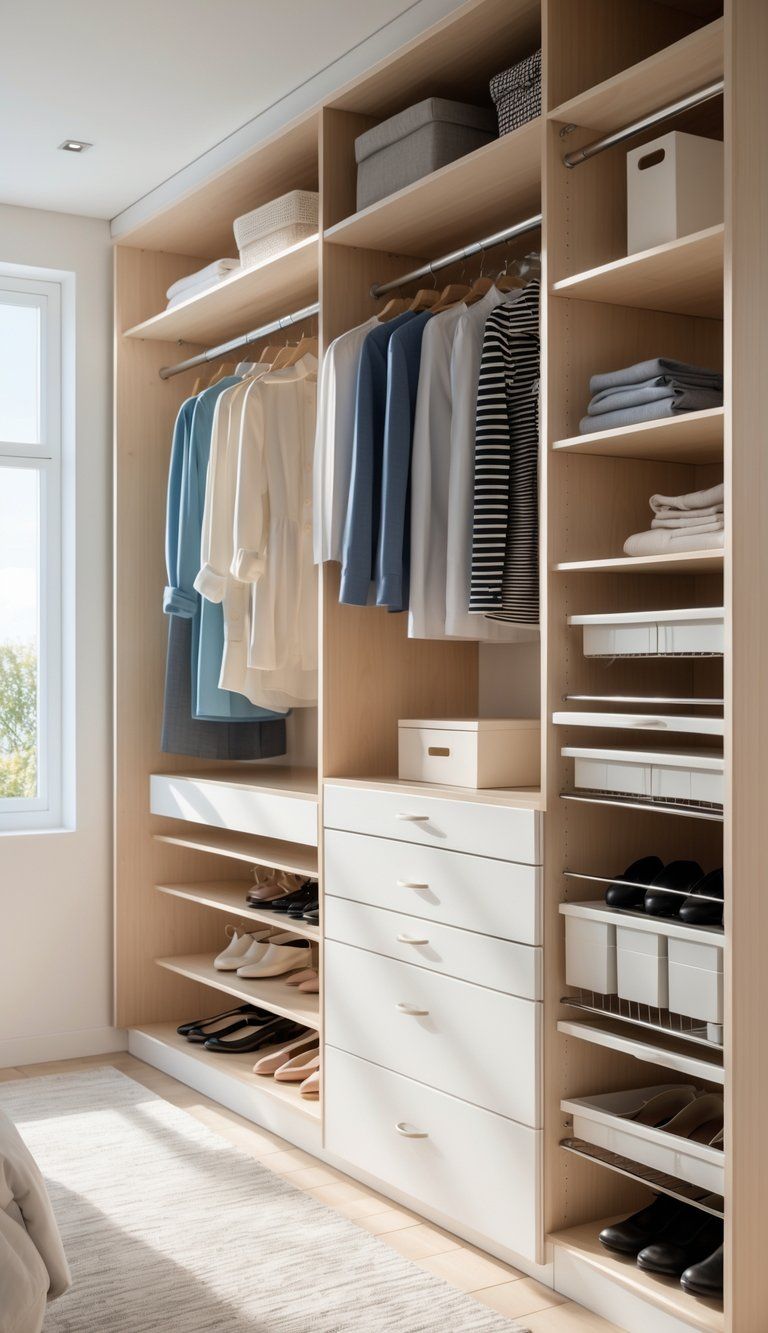
Picking the right closet system can really change how your space feels. There are a bunch of designs out there, and you can tweak them to fit your stuff, your space, and your wallet.
Wall-Mounted Closet Systems
Wall-mounted closet systems attach straight to the wall studs, giving you a floating look and freeing up floor space. Usually, you get rods, shelves, and sometimes drawers, all anchored to the wall.
Why choose this style?
- Sleek, modern vibe
- Floor stays clear for bins or shoes
- Cleaning underneath is a breeze
- Often cheaper than built-ins
Most wall-mounted systems—like the well-liked Dotted Line Grid—let you adjust shelves and rods as needed. You can move things around to fit your wardrobe.
Installing these systems means finding studs and securing everything, so it’s a bit of a DIY job. Still, a lot of people find the effort worth it since these setups can boost your storage space by up to 40% over old-school closets.
Modular Closet Systems
Modular closet systems give you building blocks to mix and match. You can set them up a million different ways.
What’s cool about modular?
- Adjustable shelves
- Drawers you can add or move
- Special storage for shoes or jewelry
- Hanging spaces that fit your clothes
These systems are super flexible. As your life changes, just reconfigure or expand. The best ones have adjustable widths to fit closets from 5 to 8 feet wide.
They work for both reach-in and walk-in closets. Many stores offer online design tools so you can plan before you buy. Prices range from about $200 for basics to several thousand for custom setups.
Freestanding Closet Systems
Freestanding closet systems skip the wall mounting. If you’re renting or like to move things around, these are a solid pick. They’re basically furniture for your clothes.
Why go freestanding?
- No drilling or tools needed
- Easy to move or rearrange
- Great for rooms without closets
- Lots of styles to match your decor
You’ll find everything from simple racks to full wardrobe units with doors, drawers, and shelves. If your closet’s tiny, these can add much-needed space.
They’re usually less expensive than built-ins, but still sturdy if you pick a quality one. Look for adjustable shelves and rods to keep things versatile. Many include shoe shelves so your footwear doesn’t end up in a heap.
Materials Used in Closet Systems
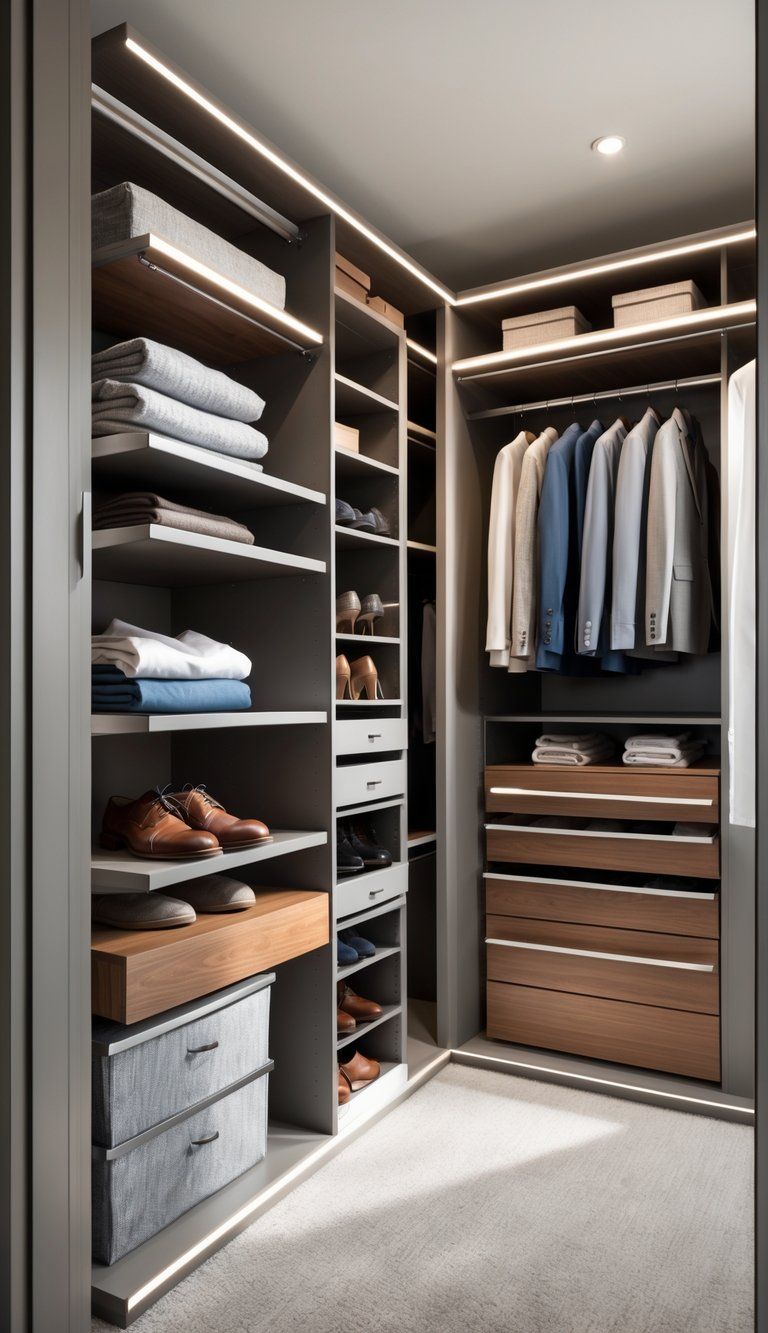
Choosing the right materials for your closet system really affects how it looks, lasts, and how much you’ll spend. Each material has its perks, whether you want something sturdy, stylish, or just budget-friendly.
Wire Shelving and Wire Shelves
People love wire shelving systems for their affordability and versatility. You’ll usually find shelves and hanging rods made from vinyl-coated steel wires.
Wire shelves let air move freely around your clothes, which helps prevent musty smells. They’re a smart pick for humid spots like bathrooms or laundry rooms.
With the open design, you can see everything you own without digging through piles. That’s a huge time-saver when you’re in a rush.
Most wire systems use a track-and-bracket setup, so installation isn’t too tricky. Many folks handle the job themselves with just a few basic tools.
Wire shelving isn’t as visually appealing as solid shelves, and small items can slip through the gaps. It’s best for bigger things or hanging clothes.
Epoxy-Bonded Steel Systems
Epoxy-bonded steel takes wire shelving up a notch in both looks and durability. These systems use steel parts coated in epoxy for extra protection and style.
The epoxy layer fights off moisture, scratches, and rust, so these shelves hold up well in damp places like coastal homes.
You get more color choices than with basic wire—white, black, and even some metallic finishes show up a lot. That modern vibe fits right in with industrial or contemporary homes.
Epoxy-bonded shelves hold a lot of weight, so you can stash shoes, books, or jeans without worry. Adjustable parts let you tweak the setup as your storage needs change.
They do cost more than simple wire shelves, but you’ll still spend less than you would on solid wood systems.
Manufactured Wood and Wood Systems
Wood closet systems bring a premium look and lots of design options. You can choose from solid hardwoods or budget-friendly choices like MDF (Medium Density Fiberboard) and melamine.
Solid wood, like cherry, maple, or oak, offers classic beauty and can last for decades if you take care of it. Of course, these are the priciest options.
MDF with laminate or veneer finishes looks like wood but costs less. It also resists warping better than solid wood in humid areas.
Melamine, made from resin-coated paper, stands up well to scratches and stains. You’ll find it in plenty of colors and wood-grain patterns to suit your style.
Wood systems usually come with more ways to customize—think drawer fronts, doors, and trim. They’re a great fit for closets in master bedrooms or main living spaces.
Maximizing Storage Capacity and Space
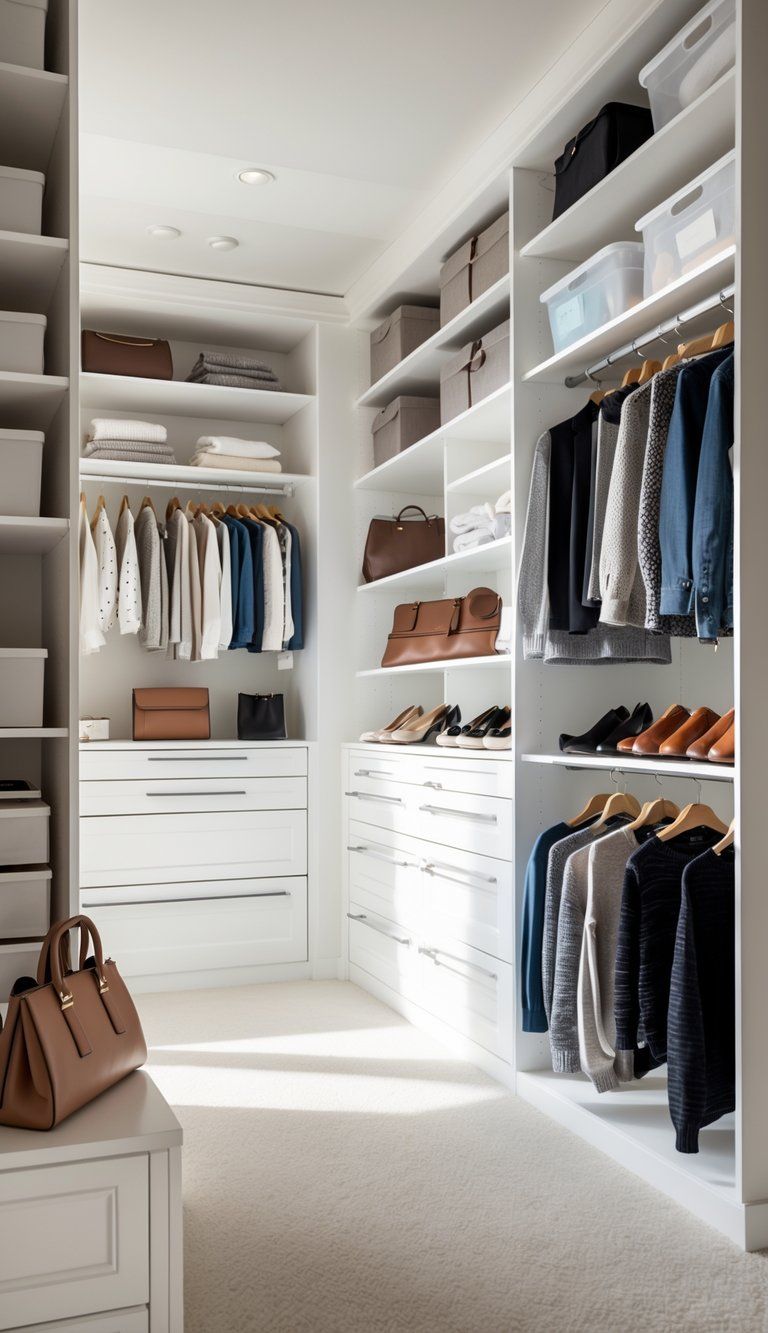
Smart closet organization squeezes the most out of every inch. If you look beyond basic shelves, you might even double or triple your storage with a few simple changes.
Utilizing Vertical Space
Most closets waste space above eye level. Add shelves up to the ceiling to store seasonal or rarely used stuff. Wall-mounted track systems attach right to the wall, giving you flexible storage that adjusts as your needs shift.
Put in a second hanging rod below your main one. Suddenly, you’ve doubled your hanging space for shirts and folded pants.
Don’t ignore the back of your closet door. Over-the-door organizers and hooks turn that forgotten spot into storage for accessories, shoes, or odds and ends.
Corner shelving units fill those awkward corners and make use of space that usually gets ignored.
Effective Storage Solutions
Clear storage bins let you see what’s inside while keeping dust out. Labeling each bin helps you find things fast, especially when they’re up high.
Vacuum-sealed bags shrink bulky winter clothes or bedding, so you can tuck them away without wasting space.
Drawer dividers keep socks, underwear, and accessories from getting mixed up. No more digging for that missing sock.
Multi-tiered hangers let you hang several garments in the space of one. These work great for pants, skirts, or scarves.
Pull-out baskets work like drawers but lift out completely, making deep shelves a lot more usable.
Height Considerations
Adjustable shelves let you change heights to fit whatever you’re storing. Leave tall spaces for boots and long dresses, shorter ones for folded shirts.
Keep everyday stuff between waist and shoulder height so you can grab it easily. That’s the “prime real estate” of your closet.
Stash seasonal or rarely used things up high. A small step stool nearby makes those shelves reachable.
For kids’ closets, put in adjustable rods and shelves that you can move as they grow. You’ll save money by not having to redo the closet every few years.
Try double-hanging sections with these heights: 42″ for shirts, 32″ for folded pants, and 60-72″ for dresses and coats.
Custom Closet Solutions
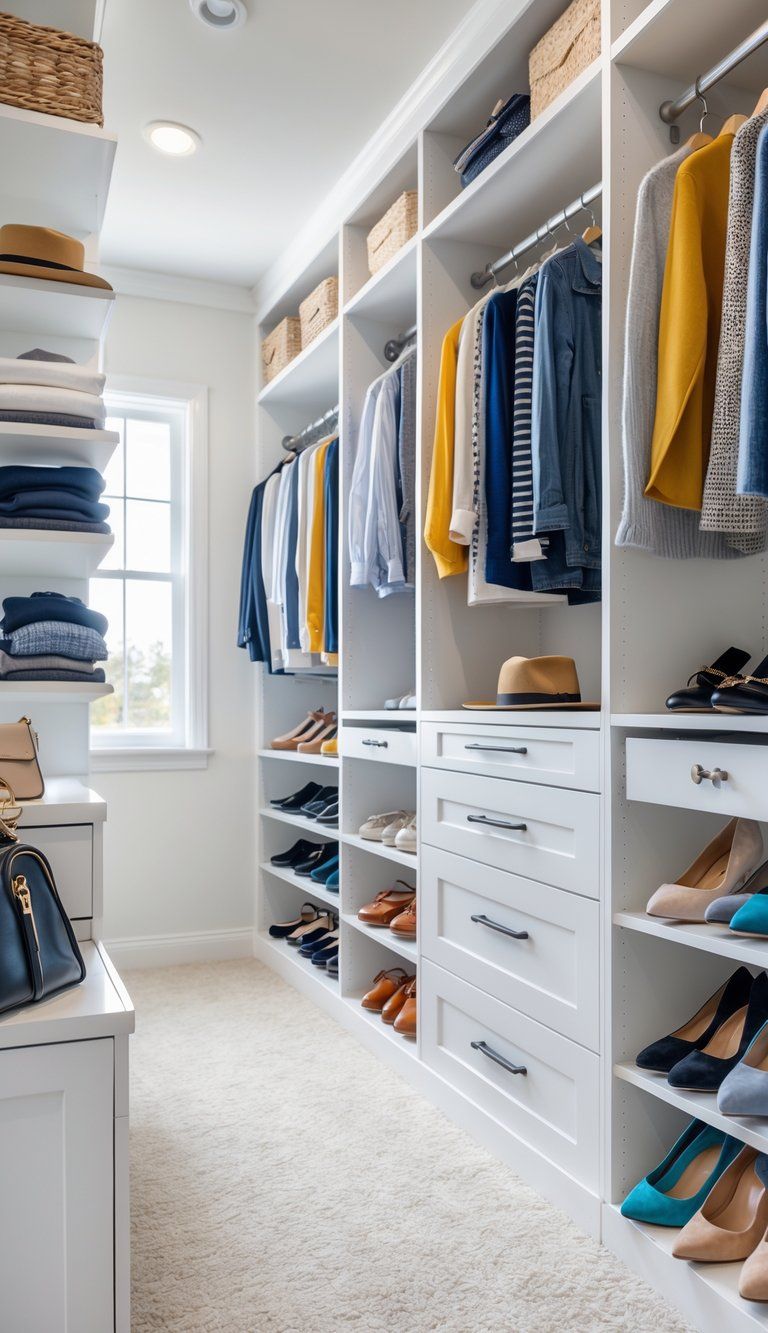
Custom closet solutions give you organization tailored to your space and style. These systems help you get the most out of your storage while showing off your personality.
Custom-Built Closet Systems
Custom-built closet systems fit your exact space and storage needs. Unlike pre-made kits, these systems get measured and built for your specific closet—reach-in or walk-in, doesn’t matter.
Professional closet companies come in, check out your space, and design a system that uses every inch. Materials range from basic laminates to high-end woods, and you can add things like:
- Custom drawer sizes
- Special hanging sections
- Built-in shoe racks
- Jewelry drawers
- Integrated lighting
Custom systems cost more than DIY kits, but you get durability and a perfect fit. Many companies back their work with warranties that last over a decade.
Tailoring Closet Design to Your Needs
Your closet needs to work for your life, not the other way around. Start by looking at what you actually keep in there and how you use it day to day.
Need more hanging space for work clothes? More shelves for folded stuff? Special storage for accessories? Figure that out first.
Add features that match your needs:
- Double-hanging for shirts and pants
- Longer hanging for dresses
- Pull-out hampers for laundry
- Valet rods for outfit planning
- Adjustable shelves for flexibility
The best custom closets grow with you. Design with the future in mind so you can tweak or expand your system later. That way, your closet stays useful for years.
Popular Closet System Brands
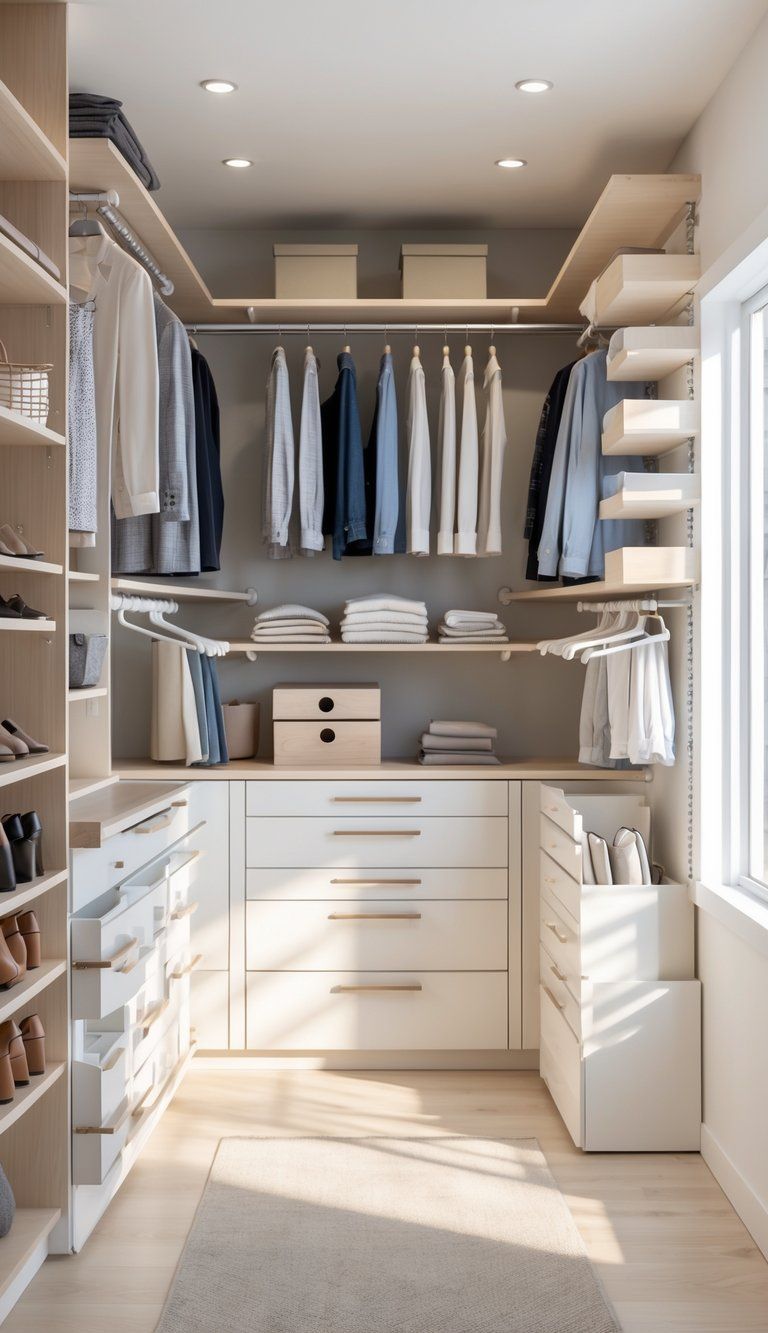
A few big names lead the closet organization world, each with their own strengths for different budgets and needs. These brands have built solid reputations for quality and smart storage ideas.
Container Store Closets
The Container Store is famous for premium closet systems that blend flexibility and style. Their Elfa system stands out—you can customize it for reach-ins, walk-ins, or even entryways.
Elfa systems use tough ventilated shelves and work as wall-mounted or freestanding units. You can easily change things up as your needs shift.
They offer free design help, which comes in handy when you want to get the most out of your space. Elfa usually costs more than budget brands, but the durability and lifetime warranty make it worth it for a lot of people.
The Container Store also has a Kids’ Closet System with adjustable parts, so it grows along with your child.
Closetmaid and Closetmaid ShelfTrack
Closetmaid delivers affordable, easy-to-find closet solutions that balance quality and price. You’ll spot their products at Home Depot, Lowe’s, and Walmart.
The Closetmaid ShelfTrack system is their most versatile option. You can adjust shelf heights and layouts without tearing everything apart. That flexibility helps families adapt as their storage needs change.
Closetmaid offers finishes like white, espresso, and natural wood tones. Their wire shelves give you good airflow and visibility, while laminate options look more finished.
Installation is simple enough for most DIYers. You’ll get clear instructions and only need basic tools.
Rubbermaid Closet Systems
Rubbermaid closet systems have a reputation for toughness and easy installation. Their FastTrack system stands out for supporting up to 150 pounds per 4-foot section.
You can set up Rubbermaid systems yourself, no problem. The parts usually mount to a single track, which keeps things straightforward. Renters and anyone who wants a fast fix will appreciate that.
Rubbermaid offers wire and laminate options at reasonable prices. Their expandable kits give you a solid starting point, and you can add more later.
Rubbermaid focuses on practical functionality instead of high-end looks. They might not win style points, but they’re perfect for garages, pantries, and places where durability matters more than appearance.
Professional Installation vs. DIY Approaches
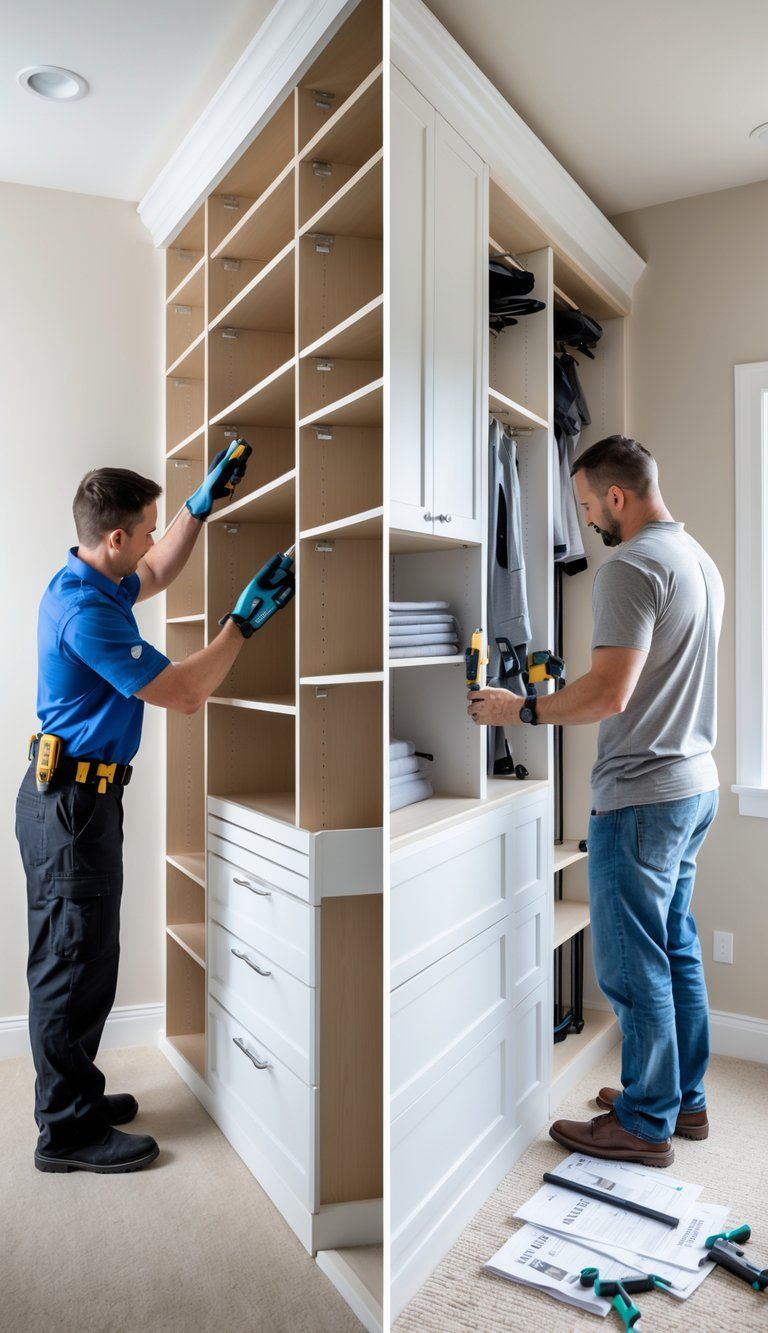
Deciding between professional installation and DIY closet systems affects your budget and your final results. Each has perks, depending on your skills, time, and how tricky your project is.
When to Hire Professionals
Professional closet installers are the way to go for complex projects or custom solutions. If you’re dealing with odd shapes, sloped ceilings, or tight corners, experts know how to make every inch count.
Professionals bring the right tools and know-how for high-quality installation. They spot issues with walls or space that most people miss.
Expect to pay $1,000-$5,000+ depending on materials and complexity, but that covers labor, materials, and usually a warranty. It’s a solid investment for your home.
Some high-end systems, like ClosetMaid’s MasterSuite, actually require pro installation to keep quality up to par.
DIY Closet System Installation
DIY installation works great for simple projects and standard closets. Lots of stores sell modular systems with easy instructions meant for homeowners.
You’ll save the most money—usually 30-50% less than hiring pros. Material costs run from $200-$1,500, depending on what you pick.
You’ll need a drill, level, stud finder, and tape measure. Most jobs wrap up in a weekend if you’ve got moderate DIY skills.
Measure your space carefully and plan things out before you buy anything. Many brands have online tools to help you visualize your setup.
Try starting with a reach-in closet before tackling bigger or more complicated spaces.
Closet Organization Tips for Every Home
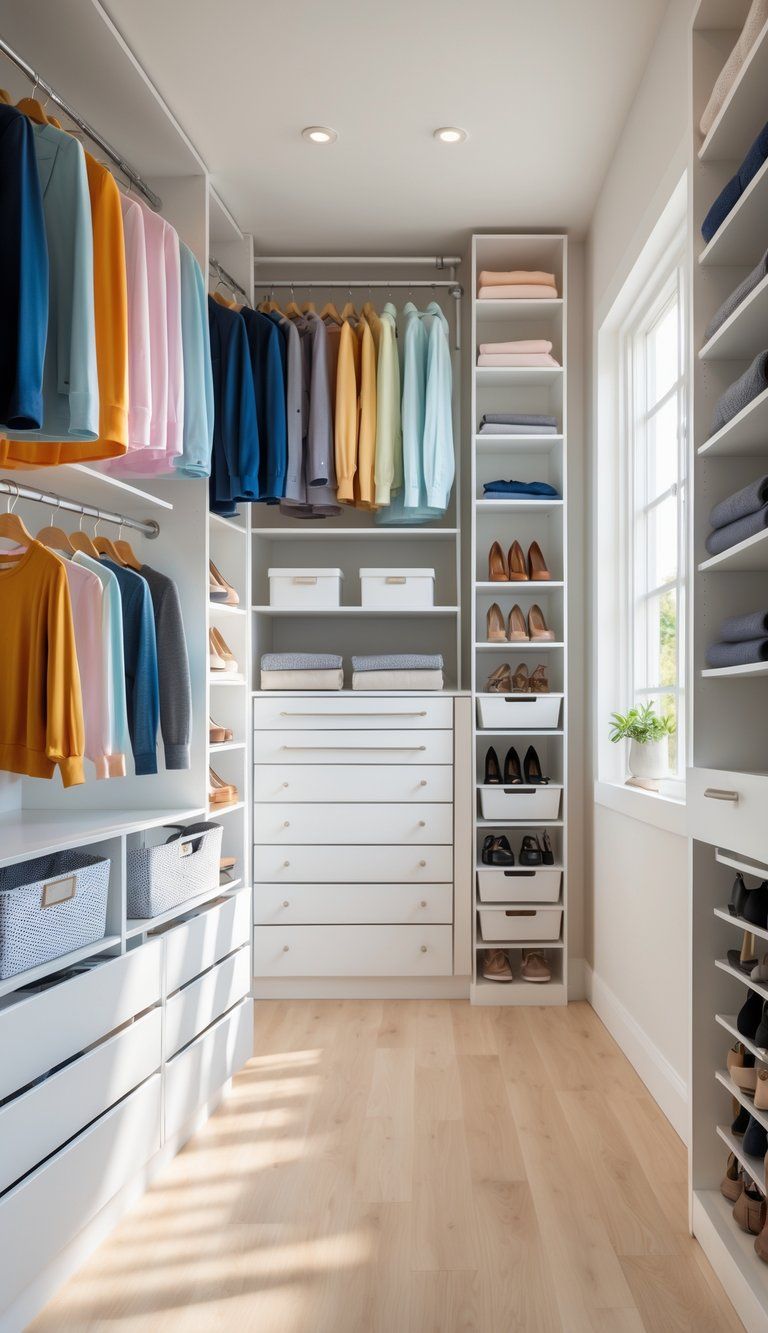
A well-organized closet can save you time and lower your daily stress. These practical tips will help you keep your storage spaces tidy and functional.
Best Practices for Organization
Pull everything out of your closet to get a clean start. Sort your stuff into keep, donate, and toss piles.
Stick with matching hangers to create a neat look and maximize space. Wire hangers save room, while velvet ones keep clothes from slipping.
Group similar items together—first by type (shirts, pants, dresses), then by color. You’ll find what you need way faster.
Install adjustable shelves so you can change things up as your wardrobe grows or shifts.
Use clear bins for seasonal items and label them clearly. No more guessing what’s inside.
An over-the-door shoe organizer handles more than shoes—use it for accessories, cleaning supplies, or anything else that tends to create clutter.
Maintenance and Long-Term Solutions
Set aside about 15 minutes each week for quick closet maintenance. Just toss any stray items back where they belong and make little tweaks if something feels off.
Try out the “one in, one out” rule. Buy something new? Let go of something old. It really keeps that mountain of unused stuff from piling up.
Rotate your clothes for the seasons to keep your closet actually usable. You can stash off-season pieces in bins under the bed or up on high shelves—freeing up that prime closet space.
Every six months or so, take a look at your closet setup. Life changes, right? Your organization should keep up.
Think about adding some closet lighting. When you can see everything, you won’t forget about those hidden shirts in the back.
Hooks are a game changer for empty wall spots. Hang up tomorrow’s outfit or your favorite robe—less stress in the morning, and it just looks neater.
Innovative Closet Features and Upgrades
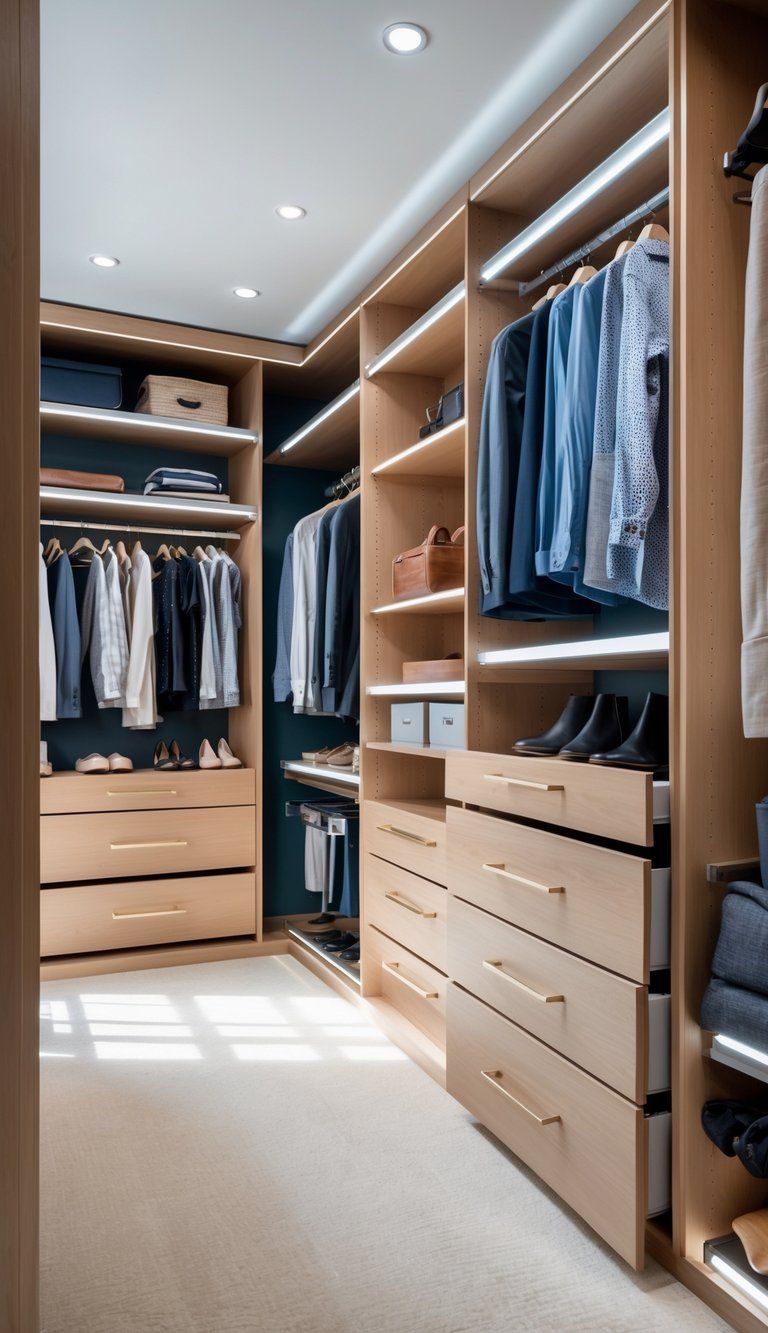
Modern closet systems come with smart features that really turn basic storage into something special. These upgrades can make your mornings smoother and, honestly, add a little extra style to your bedroom.
LED Lighting for Closets
LED lighting really changes the way you organize a closet. You can see clothing colors clearly and actually grab what you need without squinting at dawn.
Try installing LED strip lights under shelves if you want that soft, elegant glow. These lights make it easy to spot your clothes and don’t cast those annoying harsh shadows.
If you go for motion-activated LEDs, they’ll just switch on when you open the door. It’s pretty convenient, plus you don’t have to worry about wasting energy.
Recessed puck lights are great for showing off special items or brightening up those dark, forgotten corners. A lot of lighting systems now include dimmers, so you can dial the brightness up or down depending on your mood or the time of day.
You can even find color-coded LED options to sort things by season or type. Some fancier setups connect to your smart home devices—just ask your phone or smart speaker to adjust the lights.
LEDs use less power than old-school bulbs, so you’ll probably notice a drop in your electricity bill. They don’t get hot either, which feels safer, especially in tight closet spaces.

